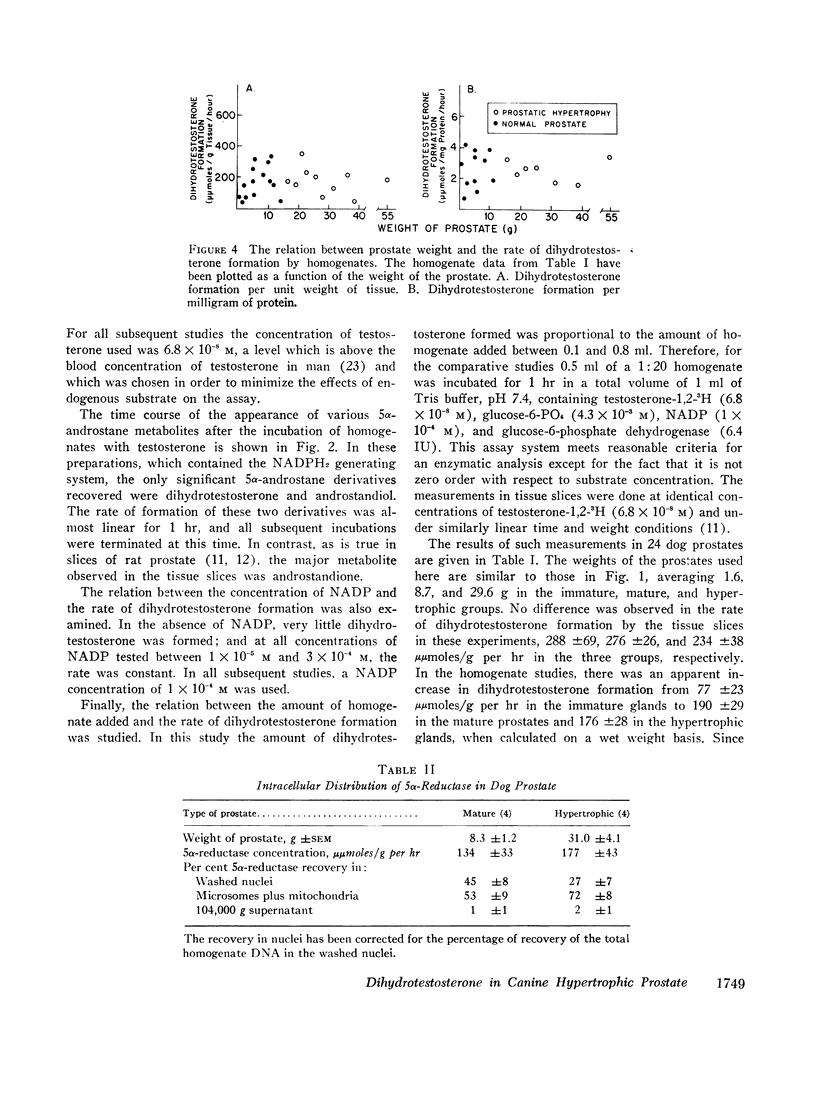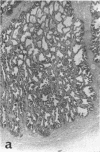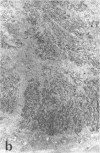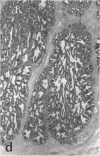Abstract
Three types of studies have been performed in immature, mature, and hypertrophic prostate glands of the dog. First, the concentrations of testosterone and dihydrotestosterone have been measured in the three types of gland. Dihydrotestosterone was the predominant hormone recovered in all prostates studied and was present in approximately five times higher concentration in the hypertrophic as compared to the other types of dog prostate. Second, pharmacological doses of dihydrotestosterone were administered to castrated dogs for 9 months and resulted in a distinct acceleration of prostatic growth as compared to testosterone treatment. Third, the rates of formation and degradation of dihydrotestosterone were measured in normal and hypertrophic tissue and were found to be essentially the same. These observations suggest that dihydrotestosterone accumulation may be causally linked to the development of canine prostatic hypertrophy. However, the mechanism by which dihydrotestosterone accumulates in the prostate remains to be determined.
Full text
PDF







Images in this article
Selected References
These references are in PubMed. This may not be the complete list of references from this article.
- BERG O. A. Parenchymatous hypertrophy of the canine prostate gland. Acta Endocrinol (Copenh) 1958 Feb;27(2):140–154. doi: 10.1530/acta.0.0270140. [DOI] [PubMed] [Google Scholar]
- BURTON K. A study of the conditions and mechanism of the diphenylamine reaction for the colorimetric estimation of deoxyribonucleic acid. Biochem J. 1956 Feb;62(2):315–323. doi: 10.1042/bj0620315. [DOI] [PMC free article] [PubMed] [Google Scholar]
- Baulieu E. E., Lasnitzki I., Robel P. Testosterone, prostate gland and hormone action. Biochem Biophys Res Commun. 1968 Aug 13;32(3):575–577. doi: 10.1016/0006-291x(68)90702-x. [DOI] [PubMed] [Google Scholar]
- Baulieu E. E., Lasnizki I., Robel P. Metabolism of testosterone and action of metabolites on prostate glands grown in organ culture. Nature. 1968 Sep 14;219(5159):1155–1156. doi: 10.1038/2191155a0. [DOI] [PubMed] [Google Scholar]
- Bruchovsky N., Wilson J. D. The conversion of testosterone to 5-alpha-androstan-17-beta-ol-3-one by rat prostate in vivo and in vitro. J Biol Chem. 1968 Apr 25;243(8):2012–2021. [PubMed] [Google Scholar]
- Bruchovsky N., Wilson J. D. The intranuclear binding of testosterone and 5-alpha-androstan-17-beta-ol-3-one by rat prostate. J Biol Chem. 1968 Nov 25;243(22):5953–5960. [PubMed] [Google Scholar]
- FOLCH J., LEES M., SLOANE STANLEY G. H. A simple method for the isolation and purification of total lipides from animal tissues. J Biol Chem. 1957 May;226(1):497–509. [PubMed] [Google Scholar]
- Gloyna R. E., Wilson J. D. A comparative study of the conversion of testosterone to 17-beta-hydroxy-5-alpha-androstan-3-one (Dihydrotestosterone) by prostate and epididymis. J Clin Endocrinol Metab. 1969 Jul;29(7):970–977. doi: 10.1210/jcem-29-7-970. [DOI] [PubMed] [Google Scholar]
- Gomez E. C., Hsia S. L. In vitro metabolism of testosterone-4-14C and delta-4-androstene-3,17-dione-4-14C in human skin. Biochemistry. 1968 Jan;7(1):24–32. doi: 10.1021/bi00841a004. [DOI] [PubMed] [Google Scholar]
- LOWRY O. H., ROSEBROUGH N. J., FARR A. L., RANDALL R. J. Protein measurement with the Folin phenol reagent. J Biol Chem. 1951 Nov;193(1):265–275. [PubMed] [Google Scholar]
- MAGGIO R., SIEKEVITZ P., PALADE G. E. STUDIES ON ISOLATED NUCLEI. I. ISOLATION AND CHEMICAL CHARACTERIZATION OF A NUCLEAR FRACTION FROM GUINEA PIG LIVER. J Cell Biol. 1963 Aug;18:267–291. doi: 10.1083/jcb.18.2.267. [DOI] [PMC free article] [PubMed] [Google Scholar]
- O'SHEA J. D. Studies on the canine prostate gland. I. Factors influencing its size and weight. J Comp Pathol. 1962 Jul;72:321–331. doi: 10.1016/s0368-1742(62)80037-x. [DOI] [PubMed] [Google Scholar]
- Ofner P. Effects and metabolism of hormones in normal and neoplastic prostate tissue. Vitam Horm. 1968;26:237–291. doi: 10.1016/s0083-6729(08)60756-6. [DOI] [PubMed] [Google Scholar]
- Siiteri P. K., Wilson J. D. Dihydrotestosterone in prostatic hypertrophy. I. The formation and content of dihydrotestosterone in the hypertrophic prostate of man. J Clin Invest. 1970 Sep;49(9):1737–1745. doi: 10.1172/JCI106391. [DOI] [PMC free article] [PubMed] [Google Scholar]
- Swyer G. I. Post-natal growth changes in the human prostate. J Anat. 1944 Jul;78(Pt 4):130–145. [PMC free article] [PubMed] [Google Scholar]






